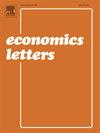信息不对称条件下的差异碳契约设计
IF 1.8
4区 经济学
Q2 ECONOMICS
引用次数: 0
摘要
碳差价合约(CCfDs)是政府支持高成本低碳项目的协议,通过补偿企业的减排量来实现。然而,信息不对称使得设计有效的合同变得困难,因为企业比政府更了解成本。本文通过机制设计表明,最优补偿应该是非线性的、凹形的。现有的项目,如荷兰和德国的项目,通常是线性的。分析表明,这些关税可能效率低下,并提出了一个分两部分征收关税的菜单,以提高效率。本文章由计算机程序翻译,如有差异,请以英文原文为准。
Designing carbon contracts for difference under asymmetric information
Carbon contracts for difference (CCfDs) are agreements where governments support costly, low-carbon projects by compensating firms based on emissions reductions. However, asymmetric information makes it hard to design efficient contracts, as firms know more about costs than governments. This paper uses mechanism design to show that optimal compensation should be non-linear and concave in emissions reductions. Existing programs, such as those in the Netherlands and Germany, are typically linear. The analysis suggests these may be inefficient and proposes a menu of two-part tariffs for better performance.
求助全文
通过发布文献求助,成功后即可免费获取论文全文。
去求助
来源期刊

Economics Letters
ECONOMICS-
CiteScore
3.20
自引率
5.00%
发文量
348
审稿时长
30 days
期刊介绍:
Many economists today are concerned by the proliferation of journals and the concomitant labyrinth of research to be conquered in order to reach the specific information they require. To combat this tendency, Economics Letters has been conceived and designed outside the realm of the traditional economics journal. As a Letters Journal, it consists of concise communications (letters) that provide a means of rapid and efficient dissemination of new results, models and methods in all fields of economic research.
 求助内容:
求助内容: 应助结果提醒方式:
应助结果提醒方式:


